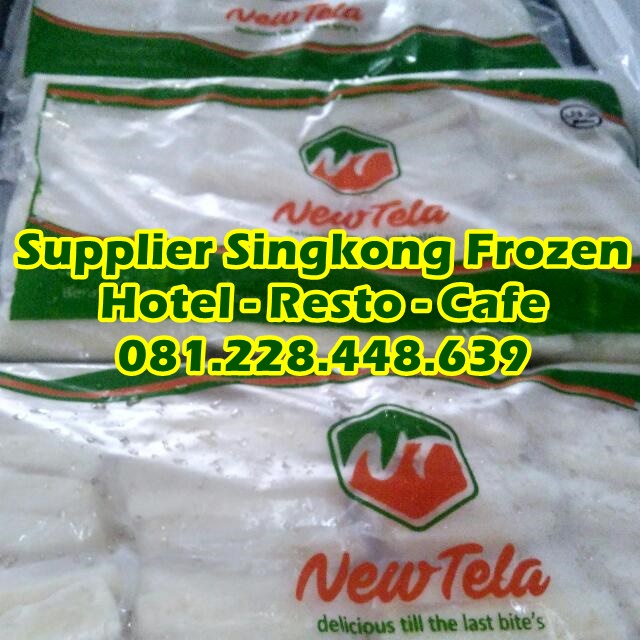081.228.448.639 Supplier Singkong Beku Hotel di Jogjakarta 2017
Produsen, Pabrik, Supplier, Agen, Distributor, Jual Singkong Ketela Beku Frozen Hotel Kafe Café Restaurant Restoran : NEWTELA
NEWTELA diproduksi dengan ahlinya dalam produksi dan franchise stik ketela / singkong crispy atau french fries singkong.
Singkong Beku Newtela kami produksi untuk membantu dan memberikan solusi pada Anda, terutama pelaku bisnis yang bingung memilih singkong yang baik untuk membuat french fries singkong, tidak memiliki waktu dan tenaga untuk menyortir, mengupas, mencuci, memotong, membumbui, hingga mengolah agar bisa empuk jika digoreng nanti.
Kami memproduksi singkong beku dengan bahan baku singkong susu terbaik, yang pasti empuk dan tidak pahit. Dengan proses yang higienis dan sehat, menghasilkan Singkong Beku yang lezat, bersih, dan ukuran singkong yang besar.
Singkong Beku Newtela sudah dibumbui, sehingga Anda bisa menekan biaya untuk membeli bumbu, dan menghemat waktu untuk menghaluskan bumbu, meracik, hingga mencampurnya. Dan bumbu ini meresap hingga keseluruhan potongan singkong.
Anda bingung bagaimana menakar per porsinya untuk dijual kembali? Tenang, Singkong beku Newtela sudah ada ‘sachet’nya di dalamnya, dikemas tersendiri per porsi, jadi tidak perlu takut lagi jika takaran satu dan lainnya tidak sama. Dan tentunya lebih memudahkan dalam persiapan menggorengnya.
Kami siap mensupplai kebutuhan singkong sebagai alternatif camilan, cemilan, menu sarapan di hotel, penginapan, villa, resto, restoran, restaurant, tempat makan dan penginapan Anda
Sangat terbuka dan peluang besar juga bagi Anda yang ingin memulai bisnis dengan modal kecil di bidang kuliner.
Pesan dan Kerjasama:
Bisa menghubungi nomor kami via WA ataupun telepon
081.228.448.639 (Telkomsel)
Atau berkunjung ke alamat kami:
Ibu Yaya (depo Newtela)
Rejowinangun KG.I/ 361 Rt 020 Rw 006 Kotagede Yogyakarta 55171




Artikel :
CASSAVA
Manihot esculenta (commonly called cassava (/kəˈsɑːvə/),[2] yuca, manioc,[2] “mandioca” and Brazilian arrowroot[2]) is a woody shrub native to South America of the spurge family, Euphorbiaceae. It is extensively cultivated as an annual crop in tropical and subtropical regions for its edible starchy tuberous root, a major source of carbohydrates. Though it is often called yuca in Spanish and in the United States, it differs from the yucca, an unrelated fruit-bearing shrub in the family Asparagaceae. Cassava, when dried to a powdery (or pearly) extract, is called tapioca; its fermented, flaky version is named garri.
Cassava is the third-largest source of food carbohydrates in the tropics, after rice and maize.[3][4] Cassava is a major staple food in the developing world, providing a basic diet for over half a billion people.[5] It is one of the most drought-tolerant crops, capable of growing on marginal soils. Nigeria is the world’s largest producer of cassava, while Thailand is the largest exporter of dried cassava.
Cassava is classified as either sweet or bitter. Like other roots and tubers, both bitter and sweet varieties of cassava contain antinutritional factors and toxins, with the bitter varieties containing much larger amounts.[6] It must be properly prepared before consumption, as improper preparation of cassava can leave enough residual cyanide to cause acute cyanide intoxication,[7][8] goiters, and even ataxia, partial paralysis, or death.[7][9] The more toxic varieties of cassava are a fall-back resource (a “food security crop”) in times of famine or food insecurity in some places.[7][10] Farmers often prefer the bitter varieties because they deter pests, animals, and thieves.[11]
The cassava root is long and tapered, with a firm, homogeneous flesh encased in a detachable rind, about 1 mm thick, rough and brown on the outside. Commercial cultivars can be 5 to 10 cm (2.0 to 3.9 in) in diameter at the top, and around 15 to 30 cm (5.9 to 11.8 in) long. A woody vascular bundle runs along the root’s axis. The flesh can be chalk-white or yellowish. Cassava roots are very rich in starch and contain small amounts of calcium (16 mg/100g), phosphorus (27 mg/100g), and vitamin C (20.6 mg/100g).[12] However, they are poor in protein and other nutrients. In contrast, cassava leaves are a good source of protein (rich in lysine), but deficient in the amino acid methionine and possibly tryptophan.[13]
